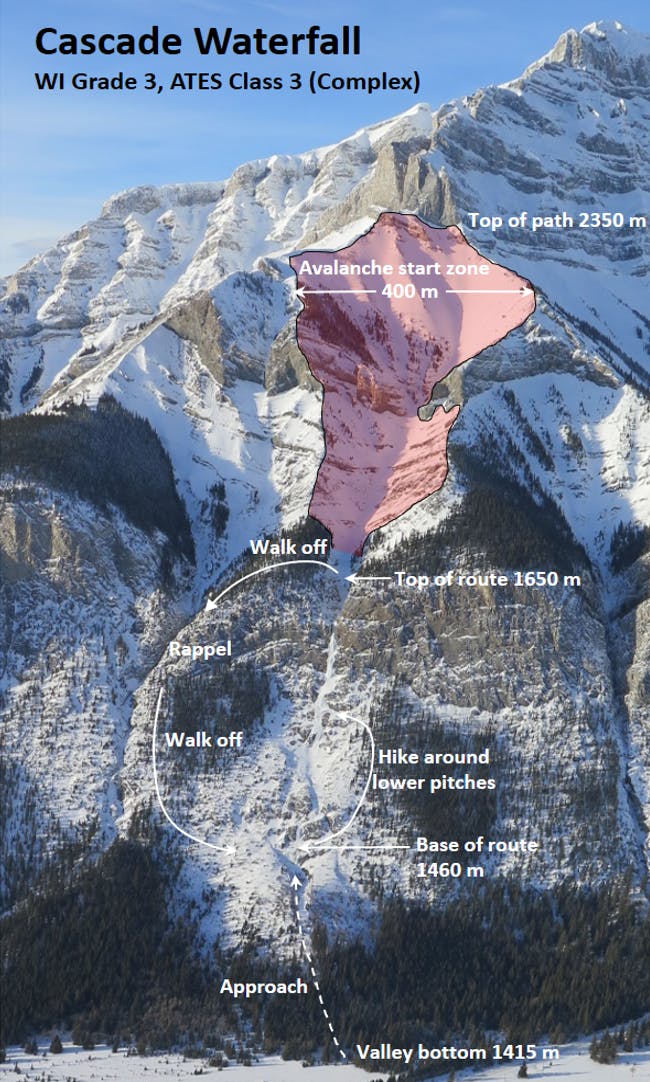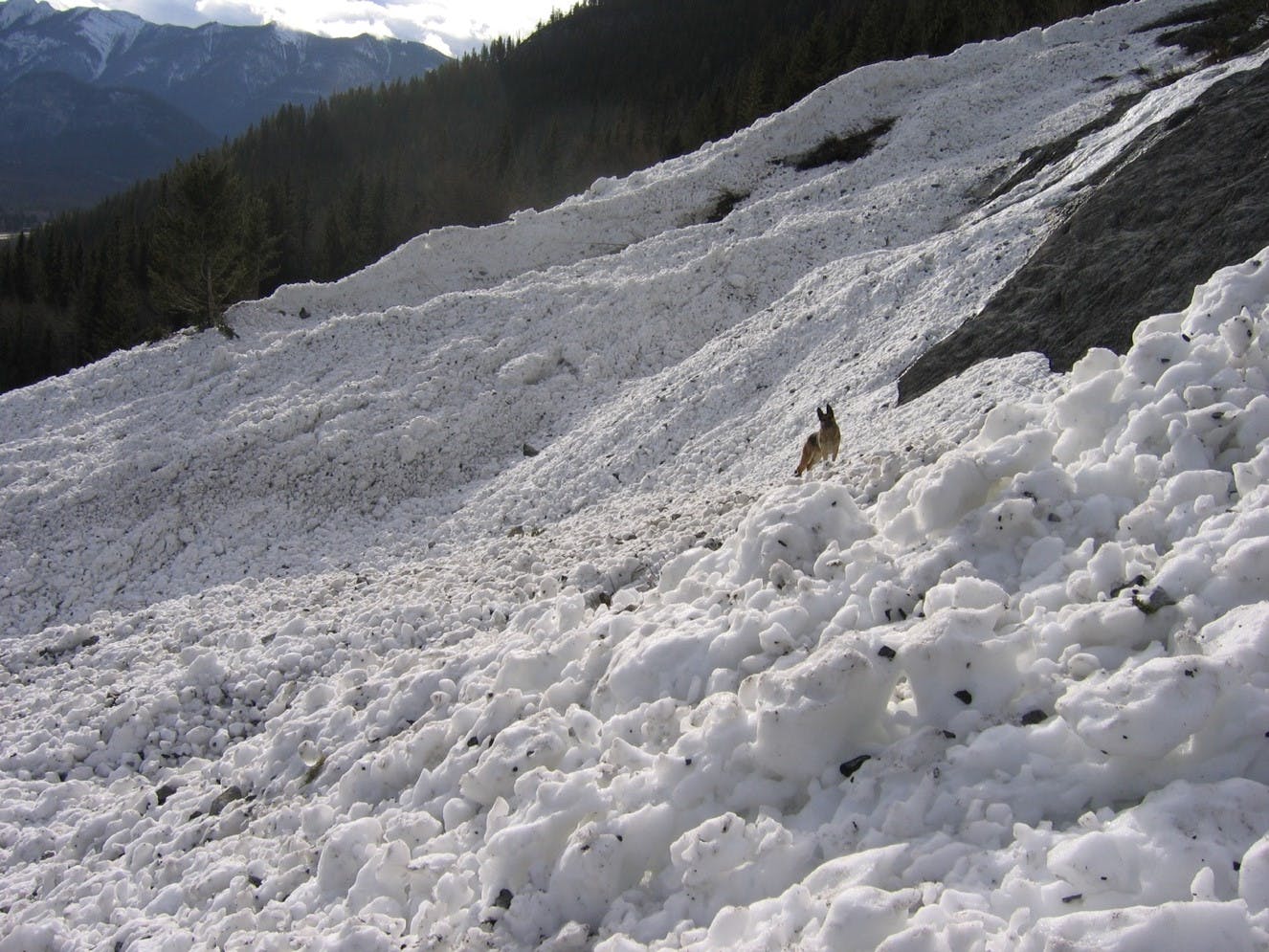Cascade Mountain
WI 3, 300 m
ATES 3 (complex)
Cascade is a prominent waterfall that can be seen from the Trans-Canada Highway as one drives west past the Banff townsite turnoffs. Proximity to the road, a moderate climbing grade, and a sunny aspect make this an obvious tick list route for any ice climber living or travelling to Banff. It has also been the site of many unfortunate accidents and has serious avalanche terrain above it.
Cascade Waterfall is a classic climb for most ice climbers. Photo: Grant Statham
Popularity
- 64 people completed the survey
- 58% climbed Cascade 1–5 times
- 16% climbed it 6–10 times
- 27% climbed it over 10 times

- Credit
- Grant Statham
Avalanche frequency
- 90% of respondents have seen debris on the climb or below it
- 10% have not seen any debris
- 36% of respondents have witnessed avalanches
Time of year and day
- February to April saw the greatest number of ascents and debris, then December to January, and lastly October to November
- 61%, of respondents witnessed avalanches between 12–6 p.m.
- 48% witnessed avalanches between 6 a.m. to 12 p.m.
Avalanche start zones:
- 59% believe the avalanche started well above the climb
- 28% believe it started right above the climb
- 14% were unsure where it started
Runout debris
- 73% of respondents saw debris at the base of the climb
- 50% saw debris in between the pitches of climbing
- 41% saw debris above the last pitch
- 8% saw debris on the walk off
Notes on avalanche debris
- Many people noted seeing debris all the way past the base of climb, up to several meters deep. Debris from large avalanches seen as early as December to spring.
- Many noted avalanche debris along the climb in the flatter sections of the rambling pitches and before the steeper pitches.
- Many noted debris before the final pitch that many perhaps don’t climb, and above this as well.
- One person wrote: “I think it runs full path about every four to six years. It runs mid path pretty much every year at some point. While it can be quite destructive like the class 3+ that took out the timber climbers left 20 some years ago. The normal full path over just the waterfall likely about meter in depth. I like to think this fairly predictable but you have to be on top of loading and how often it ran in order to make that prediction. safe to say if it has not run ( no debri on route) and your in a high avy cycle best avoid the route.”
Searching avalanche debris beneath Cascade Waterfall. Photo: Grant Statham.

Reported avalanches and incidents:
- From Accidents in North American Mountaineering, Dec. 17, 1999:
“Avalanche rating for the day was High in alpine/Considerable in tree line. Bulletin explained Nov crust and easy results. Climbers noted however terrain above Cascade looked bony. By midday a strong warm wind was blowing the snowpack above Cascade. Size 2 likely on the Nov crust on a SE slope at 2130m from strong warm winds.
“Top 2 climbers were descending. 1 had rapped the final curtain and was standing unroped in the notch when the avalanche came down and swept him down the climb. The other climber was rappelling and was able to move out of the way.
“The avalanche, along with rocks hit the other groups that were already rescuing another climber that had fallen unroped and had died from result of his fall but no one was buried. Some injured.” - In the late 1980’s (unsure of exact year), two climbers had completed a spring ascent of the rock climb Lion’s Layback to the right of Cascade Waterfall. While walking off, they were crossing the gully of Cascade Waterfall when they were struck by a large wet avalanche. One person managed to escape while the other person was swept over the top of Cascade Waterfall and fell approximately 500 m, stopping in the trees below. The person sustained serious injuries but survived.
- Feb. 14, circa 1995, party of two. We were soloing the lower pitches when a wet heavy slide hit us, likely around 9 a.m. We were climbing at the time (not stood on a ledge, etc.), but I was able to hug into the ice and very narrowly avoided being ripped off. I recall it tugging at my shoulder at one point and I thought I was going to lose my balance and get taken off, but I was able to duck in tighter. Once the snow eased and I was able to stop swearing profusely, I looked for my partner but couldn't see him. But he was there just tucked in too, directly below me. His helmet was jammed with snow but he was there and alive. I am not sure if the avalanche started above the route or from the pocket of snow in the middle of the route. We got the hell out of there before anything further arrived. I once recall being told by a Rockies ice icon that he regarded the route as often being dangerous after the first post-Christmas dump of snow. We had consulted a Banff local climber the day before and he said he thought it would be “safe.”
- Over 30 years ago, when forecasting was less available then today, I was with a group on the far climbers left side of the lowest ice on the approach. It was not our intention to proceed any higher than this area. Time of day was still well before noon and our intention was to only spend a few hours at the lowest ice below the main climbing pitches. There was an inversion and despite the fact temperatures were well below freezing in the valley, temperatures were obviously (in retrospect) much warmer in the bowl above. Solar radiation and warm temps at upper elevations combined to initiate an estimated size 2 loose wet avalanche that flowed over the upper pitches of the climb. My group was off to the side of the main flow of debris but a portion of the flow came over to the side where we were located. At the same time an unrelated group of two climbers were ascending toward the route in the centre with the intention of climbing Cascade Waterfall proper. They were soloing and still well below the start of the actual technical climbing. The debris engulfed these two climbers and carried them a short distance down the slope. The debris was slow moving and they remained upright and appeared to be partially buried less than waist deep. I did not have any further contact with them other than to shout over to find that they were unharmed and walking down. There were no injuries in either group. Parks Canada did respond since the avalanche was witnessed from the road. Most of the group walked to the road unassisted.
- I have seen avalanches to the bottom occur twice. Both times I searched the debris after the slide. I also saw a slide to the bottom in May.
- Human triggered size 0.5, lee loaded wind slab on the initial walk off.
- Experienced a loud whumpf while travelling on snow slope to upper pitch. We quickly reversed the route.
- A soloist passed us and triggered a small wind slab avalanche above us at the top of the main flow of the climb, before the last top out pitch to access the walk off. Fortunately, it did not propagate more than a few metres.
- 12 separate people noted seeing large avalanches come over Cascade from the car or parking lot at various times of the day and year.
Contributing factors:
- Winds: 65%
- Warming and solar radiation: 59%
- New snow amounts: 46%
- Known reactive layer: 18%
- Cornice or human/animal trigger: 14%
Descent
- 86% said they used the walk off
- 39% said they rappeled the route.
- Other: There is this new way people seem to descend: rap the top steep pitch, walk down the middle section staying skiers left around to the second bulge of ice, then back skiers right to the rock above the very first approach slab. There is a two bolt anchor there for a short 12 m or so rappel.
Summary:
- Proximity to the road and relatively easy climbing make this a classic climb for most ice climbers.
- It’s common to have many parties, including soloists, on the route at the same time.
- The route can take longer than one might expect if using a rope for all the pitches.
- The walk off offers a way to get out of avalanche terrain for the descent.
- The sunny aspect is an additional avalanche factor to consider.
- The sunny aspect also adds an additional hazard of ice fall from the crux pitch in particular.